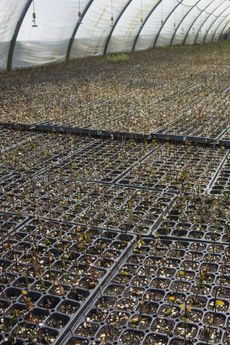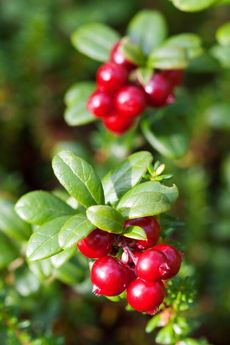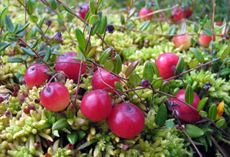Cranberry Vine Care - Learn How To Grow Cranberries At Home


Growing cranberries may seem a far-fetched idea in the home garden, but it is plausible when you have the right conditions. Keep reading to learn how to grow cranberries if this is something you would like to try.
What are Cranberry Plants?
Cranberry plants, or Vaccinium macrocarpon, are woody, low growing perennial vines. Native to the temperate zones of the east coast, the central U.S., and from southern Canada in the north all the way to the Appalachian mountain range in the south, cranberries are often harvested commercially in water, but contrary to popular belief, actually flourish when grown on dry land. Cranberry plants grow runners measuring from 1 to 6 feet (31 cm. to 2 m.) long with dark green, glossy leaves during its growth phase and reddish brown during the dormant season. Along the runners, short vertical branches develop and form flower buds jutting above the matted vines. From these branches, berries form.
How are Cranberries Grown and Can You Grow Cranberries at Home?
Commercially grown cranberries are often grown in bogs, which have evolved naturally from glacial receding, causing holes that over time filled with water and decayed matter. As mentioned above, however, growing cranberries can occur on dry land as well, provided there are a few requirements. Can you grow cranberries at home? Yes, and now the question is how are cranberries grown in the home garden? The first thing to determine how to grow cranberries is the pH of your garden soil. Cranberries are a member of the Ericaceae family and, as such, are best suited to a soil pH of less than 5. You will want to test your soil to determine pH and also make sure you have very well draining soil, or amend the soil with sand. The second major consideration when attempting cranberry vine care is irrigation. If you have very alkaline water, this will affect the pH of your soil and may render it unsuitable for growing cranberries. The final test, which answers the question, “Can you grow cranberries at home?” is to determine what the climate is like in your region. Cranberry plants need cold weather in order to trigger a dormant phase, approximately three months of temperatures in the 32 to 45 degree F. (0-7 C.) range. Some areas of the country will not be suitable for cranberry planting.
How to Grow Cranberries
When everything above is checked off your list, it's time for the basics of cranberry vine care. Growing cranberry plants from seed is not recommended. Plants may be obtained through mail order, the Internet, or if you reside in an area of commercial cranberry farms, possibly from a grower. To make things easier, purchase rooted seedlings, which are usually in a 1 inch (2.5 cm.) diameter pot. Plant one rooted cranberry cutting per square foot, which should fill in within one or two years. It is unnecessary to put fertilizer in the hole as long as the rooted section is substantial. Plant cranberry plants after the last major frost in the spring depending on your location. Water daily for the first couple of weeks until the seedlings have established and thereafter every couple of days, or keep moist but not drenched. Fertilize every three to four weeks with slow release fertilizer and follow up regularly with a balanced liquid fertilizer.. Hand weed as needed. Protect cranberry vines from damage during winter conditions with a thick layer of mulch such as pine boughs. Snow accumulation may become a protector of sorts as well. Fruit of the cranberry plants will become apparent the year after planting, but more likely the second year depending on the number of pollinators visiting your cranberry plot.
Gardening tips, videos, info and more delivered right to your inbox!
Sign up for the Gardening Know How newsletter today and receive a free download of our most popular eBook "How to Grow Delicious Tomatoes."

Amy Grant has been gardening for 30 years and writing for 15. A professional chef and caterer, Amy's area of expertise is culinary gardening.
-
 10 Best Apartment Plants To Turn Your Small Space Into An Oasis
10 Best Apartment Plants To Turn Your Small Space Into An OasisThe best apartment plants can lend an ambience of the tropics, brighten up a space, or add a touch of drama, and turn an apartment into a relaxing oasis.
By Amy Grant
-
 Grow a Bathroom Oasis: 8 Best Bathroom Plants With No Light or Low Light
Grow a Bathroom Oasis: 8 Best Bathroom Plants With No Light or Low LightSome apartment dwellers grow the best bathroom plants with no light or low light. Read how one of our favorite plant lovers does it in the big city.
By Teo Spengler
-
 Growing Cranberries From Cuttings: Tips For Rooting Cranberry Cuttings
Growing Cranberries From Cuttings: Tips For Rooting Cranberry CuttingsRooting cranberry cuttings may require some patience, but for the dedicated gardener, that's half the fun. Interested in trying your own cranberry cutting propagation? Find out how to root cranberry cuttings in this article. Click here for more info.
By Amy Grant
-
Preventing Cranberry Diseases: How To Treat A Sick Cranberry Plant
Cranberries are a quintessentially American fruit that not many people even realize they can grow at home. If you?re one of the lucky few who have cranberries in their garden, odds are you?re very protective of them. Learn how to treat a sick cranberry plant in this article.
By Liz Baessler
-
 Cranberry Insect Pests: How To Treat Pests On Cranberries
Cranberry Insect Pests: How To Treat Pests On CranberriesCranberries are wonderful fruits that not many people think they can grow at home. If you?re one of the lucky few with your very own cranberry vines, you might be devastated by the sudden invasion of insects. Learn more about cranberry pest management here.
By Liz Baessler
-
 Cranberry Companion Plants: What To Grow Near Cranberries
Cranberry Companion Plants: What To Grow Near CranberriesWhenever you decide to plant anything, you should learn about the plants that are companions to it in order to maximize your plants? performance. This is exactly what I did with my cranberry plants. Click here to learn more about plants that grow well with cranberries.
By Shelley Pierce
-
 Problems With Cranberries: Common Fixing Cranberry Diseases And Pests
Problems With Cranberries: Common Fixing Cranberry Diseases And PestsIf you?re looking for an unusual addition to your garden this year, cranberries are where it?s at. But before you dive into the bog head first, make sure you read up on some of the most common problems that can affect this sweet tart of a crop. This article will help.
By Kristi Waterworth
-
 Potted Cranberry Plants – Tips On Growing Cranberries In Containers
Potted Cranberry Plants – Tips On Growing Cranberries In ContainersBerry producing plants like cranberries are now being added to multi-functional container designs. You may be thinking: hold on a minute, potted cranberry plants? Don't cranberries grow in large bogs? In this article, we will discuss growing cranberries in containers.
By Darcy Larum
-
 Cranberry Propagation Tips: How To Propagate Cranberries In The Garden
Cranberry Propagation Tips: How To Propagate Cranberries In The GardenHave you ever wondered how to propagate cranberries? If you, too, are interested in cranberry propagation, click on the following article to find out useful information on reproducing cranberries. Learn more here.
By Amy Grant
-
 Different Cranberry Varieties: A Guide To Common Types Of Cranberry Plants
Different Cranberry Varieties: A Guide To Common Types Of Cranberry PlantsCranberry season is looked forward to and celebrated from fall into winter. Yet, even cranberry devotees may not know much about this little berry, including different cranberry varieties because, there are several varieties of cranberry. Learn about them here.
By Amy Grant